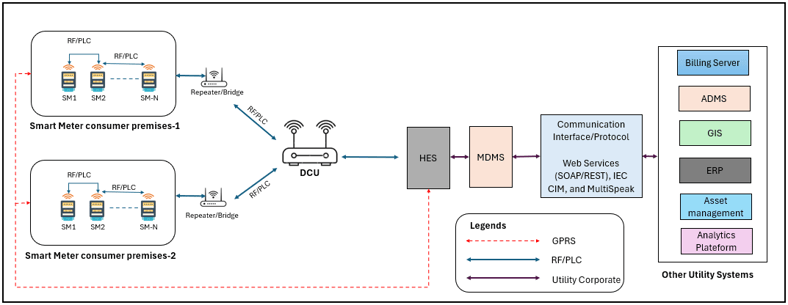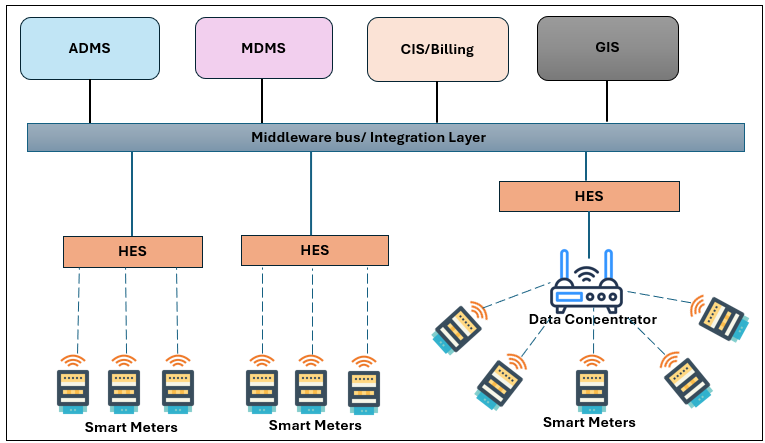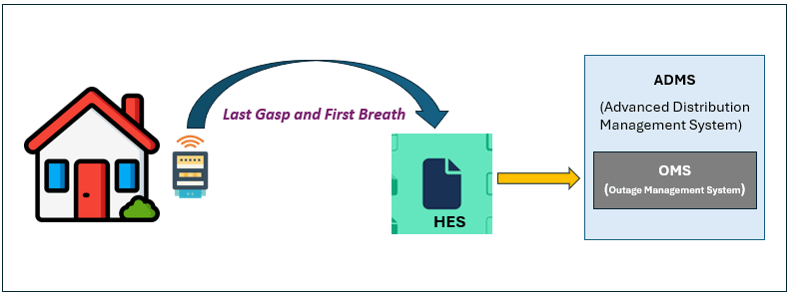In today’s rapidly evolving energy landscape, the integration of Advanced Metering Infrastructure (AMI) and Advanced Distribution Management Systems (ADMS) is essential for modern utilities, enhancing both operational efficiency and customer satisfaction. By combining AMI's precise energy consumption data collection with ADMS's comprehensive grid control, utilities can optimize performance and reliability. This synergy allows for better energy demand prediction, efficient distribution, and proactive resolution of issues such as malfunctioning transformers. Furthermore, it enhances outage management by quickly identifying and isolating faults and improves load balancing by dynamically adjusting power flows based on real-time data. This integration also supports the incorporation of renewable energy by maintaining real-time balance between supply and demand. Ultimately, the result is a smarter, more resilient, and customer-centric energy system, offering benefits like improved service alerts and maintenance.
| AMI (Advanced Metering Infrastructure) |
ADMS (Advanced Distribution Management System) |
| A comprehensive system encompassing smart meters, communication networks, and data management systems. |
An advanced software platform for monitoring, controlling, and optimizing electricity distribution. |
| Facilitates two-way communication between utilities and the smart meters at customers' premises. |
Components include SCADA (Supervisory Control and Data Acquisition), DMS (Distribution Management System), and OMS (Outage Management System). |
| Smart meters record detailed energy consumption in near real-time and transmit the data via secure networks. |
Offers comprehensive real-time monitoring, predictive analytics, and decision support for load and network management. |
| Enables real-time data collection, enhancing billing accuracy and customer service. |
Maximizes asset utilization by dynamically adjusting load distribution. |
| Enables rapid issue identification and resolution, provides detailed energy usage insights, and offers customized energy-saving recommendations for customers. |
Improves outage management by minimizing downtime and enhancing customer satisfaction through swift issue resolution. |
Synchronizing Systems: Exploring the Technical Integration of AMI and ADMS
In the field of information management, AMI is leading the way in revolutionizing how utility companies manage their power networks. AMI utilizes smart meters with advanced communication capabilities to automatically collect data without manual intervention. These smart meters use various technologies, such as cellular signals, similar to how a phone receives reception, or radio waves (RF Mesh), like radio broadcasts, to transmit data back to the utility company's systems. Some meters even use power lines (PLC) to send information, like messages traveling through wires.
These smart meters gather various data points from homes and businesses. They monitor electricity consumption akin to a virtual meter reader and can also measure additional variables. These include voltage, which indicates the electricity flow force through wires, and current, which measures the instantaneous electricity flow. They also record usage patterns, tracking electricity consumption throughout the day. Moreover, they detect outages and promptly alert the utility company to any issues. Consequently, AMI not only aids in tracking electricity usage for utility companies but also improves overall management of the power grid.
 AMI Communication Architecture
AMI Communication Architecture
The interaction between AMI and ADMS relies on robust communication standards such as Web Services (SOAP/REST), IEC 61968/61970 (CIM), and MultiSpeak, ensuring seamless data transmission. These standards enable real-time grid monitoring and control, ensuring data accuracy and minimal delay. Accurate data enhances decision-making in ADMS, thereby enhancing grid reliability and efficiency. Minimizing delay is critical for timely responses to grid events, ensuring grid stability, and maintaining uninterrupted customer service. A well-established communication system facilitates effective management of the grid network, optimizing resources and enhancing performance.
ADMS and AMI systems must exchange various types of data with differing latency requirements. Meter readings collected frequently (e.g., every 15 minutes), can tolerate some delay, prioritizing reliability. Conversely, event data (such as power outages) and control commands (sent from ADMS to AMI devices) necessitate rapid response times, ideally within seconds or milliseconds for real-time control. To achieve this, AMI data can be filtered and prioritized through a middleware system, while robust and high-bandwidth communication networks are crucial for swift transfer. Additionally, standardized data formats ensure seamless communication between the two systems. Understanding these data types and their latency needs is crucial for effectively integrating ADMS and AMI, especially with the increasing deployment of Distributed Energy Resources (DERs) in the grid.
System Architecture:
Integrating AMI with grid operations presents challenges for power utilities due to the high volume and accuracy demands of the data. AMI systems generate numerous signals per meter, which can overwhelm operators or systems, especially when integrated with an OMS requiring timely and pertinent information for effective outage response. Deploying a middleware system to filter and handle AMI data ensures that only actionable and relevant signals are forwarded to the OMS. This allows utilities to manage AMI data in nearly real-time, enhancing their capability to pinpoint outage origins, communicate with customers, and respond promptly and securely to outages.
 AMI - ADMS Integration Architecture
AMI - ADMS Integration Architecture
AMI systems provide detailed, time-interval readings for accurate and timely energy consumption billing. Additionally, each smart meter is equipped with a small energy storage device that transmits a "last gasp" signal when the grid loses power and a "first breath" signal when power is restored.
| Feature |
Last Gasp |
First Breath |
| Function |
Notifies the Head End System (HES) in the event of a power failure. |
Notifies the Head End System (HES) upon power restoration. |
| Process |
The HES transfers data to the Outage Management System (OMS), facilitating expedited power restoration. |
Enhances the "Last Gasp" functionality by enabling smart meters to swiftly reconnect and resume communication with the utility network after power restoration. |
| Impact |
Minimizes the duration and impact of power outages, thereby improving overall operational efficiency through accurate data for billing, planning, and troubleshooting purposes. |
Ensures immediate restoration of connectivity, maintaining continuous and accurate data collection, thereby enhancing utilities' capability to effectively monitor and manage the network. |
 Power Outage Notification (Last Gasp and First Breath)
Power Outage Notification (Last Gasp and First Breath)
Challenges in Integration:
Integrating Advanced Metering Infrastructure (AMI) and Advanced Distribution Management Systems (ADMS) in the smart grid poses several intricate challenges.
Data Management:
- Handling large volumes of data from AMI.
- Meeting real-time data demands for ADMS tasks such as outage detection and renewable energy management.
- Managing diverse latency requirements within a unified system.
Efficient Data Storage:
- Avoiding data overload.
- Ensuring timely retrieve for both AMI and ADMS.
Cybersecurity Risks:
- Greater vulnerabilities from interconnected systems.
- Strong security measures are required to safeguard sensitive data.
System Interoperability:
- Disputes in communication between different vendors' systems.
- Modifying protocols and standards complicate integration.
Collaboration and Standardization:
- Necessity for stakeholder collaboration.
- Implementation of standardized protocols.
- Expansion of scalable storage solutions.
Benefits of AMI and ADMS Integration:
The integration of AMI and ADMS offers a comprehensive suite of benefits that enhance network management, outage management, operational efficiency, predictive analysis, voltage profiling, and overall customer experience.
| Use Case |
How to Accomplish |
Benefits |
| Improved Outage Management |
- Establish communication protocols between AMI and ADMS to ensure near real-time data flow.
- AMI detects and reports outages in real-time.
- Implement outage prediction algorithms for swift response and restoration.
- ADMS utilizes AMI data to quickly predict and localize outages.
|
- Accelerated and precise identification of outage locations.
- Expedited restoration times.
- Enhanced communication with impacted customers.
|
| Real-Time Load Monitoring and Management |
- Integrate AMI data streams with the ADMS platform.
- AMI gathers detailed energy consumption data from consumers.
- Develop algorithms for real-time monitoring and load balancing.
- ADMS employs AMI data to improve grid performance in real-time.
|
- Facilitates dynamic load management.
- Enhances the efficiency of supply-demand balance
- Lowers peak loads and prevents grid overloads.
|
| Enhanced Demand Response Programs |
- Analyze historical AMI data to identify demand patterns.
- AMI furnishes detailed consumption data over time
- Deploy demand response strategies and engage customers via AMI-enabled platforms.
- ADMS utilizes AMI data to effectively implement demand response strategies.
|
- Promotes customer efforts to reduce or shift electricity usage during peak times.
- Become stable the grid.
- Decreases reliance on costly peaking power plants.
|
| Distributed Energy Resource (DER) Management |
- Deploy AMI-enabled meters to collect DER data
- AMI monitors the output and status of DERs.
- ADMS manages DER data and strategizes optimal usage for grid stability and reliability.
- ADMS integrates DER data to improve grid reliability and efficiency.
|
- Better visibility and control over DERs.
- Improved integration into the grid.
- Enhanced reliability.
- Allows new services like virtual power plants
|
| More Accurate and Timely Billing |
- Incorporate AMI data streams into the billing system.
- AMI delivers accurate and timely consumption data.
- Develop automated billing algorithms to process data in real-time.
|
- Minimizes billing errors.
- Improves customer satisfaction with prompt and accurate bills.
- Simplifies the billing process.
|
| Proactive Outage Notifications and Quicker Resolutions |
- Established real-time data flow between AMI and ADMS for outage detection.
- AMI promptly detects and reports outages.
- Create a communication system for automated outage notifications to customers.
- ADMS leverages AMI data to analyze and predict outage impacts, facilitating quicker resolutions.
|
- Reduces downtime for customers.
- Enhances communication and transparency with customers.
- Improves overall grid reliability and response times.
|
| Using Consumption Data for Energy Efficiency Programs |
- Analyze AMI data to uncover consumption patterns and inefficiencies.
- AMI delivers granular consumption data for in-depth analysis.
- Develop and implement energy efficiency programs based on these insights.
- ADMS leverages AMI data to create targeted energy-saving initiatives.
|
- Supports customers to reduce energy consumption.
- Reduces overall energy dem
|
The combination of AI, distributed intelligence (DI), and edge technology greatly amplifies the benefits of the mentioned use cases by enabling advanced data analysis and real-time decision-making. AI algorithms can accurately predict equipment failures and optimize load balancing, while DI supports decentralized processing, allowing devices to autonomously manage outages and demand response programs more swiftly. Edge technology processes data locally, reducing latency and enabling faster outage responses, more precise billing, and efficient energy efficiency programs. Together, these technologies contribute to a more resilient and efficient energy grid.
Looking Ahead: Future Directions and Concluding Thoughts:
Emerging technologies are transforming the energy sector, particularly in integrating renewables like solar and wind into the grid. Enhanced by IoT, AI, DI, and edge technologies, advanced systems such as AMI and ADMS optimize grid performance and resilience. IoT devices facilitate real-time monitoring and control, while AI utilizes AMI data to predict demand, optimize distribution, and detect anomalies. DI and edge technology facilitate decentralized processing and real-time decision-making at the source, reducing latency and improving response times. Through innovation, collaboration, and strategic planning, utilities can pave the way for a smarter, sustainable energy future.
Regulatory and policy considerations are crucial in shaping integration efforts within the energy sector. Well-defined and supportive regulations promote investments in technologies such as AMI and ADMS, facilitating the integration of renewable energy. These frameworks prioritize standardization and compliance, ensuring seamless interoperability and data exchange. A conducive regulatory environment promotes transparency, reliability, and accountability, essential for fostering innovation and successful integration initiatives.





 AMI Communication Architecture
AMI Communication Architecture AMI - ADMS Integration Architecture
AMI - ADMS Integration Architecture Power Outage Notification (Last Gasp and First Breath)
Power Outage Notification (Last Gasp and First Breath)











